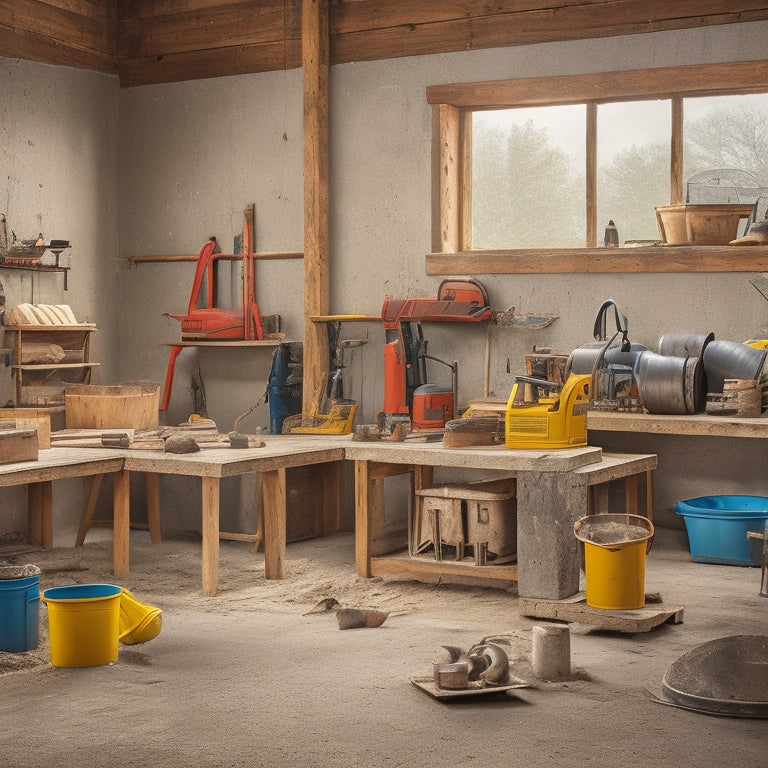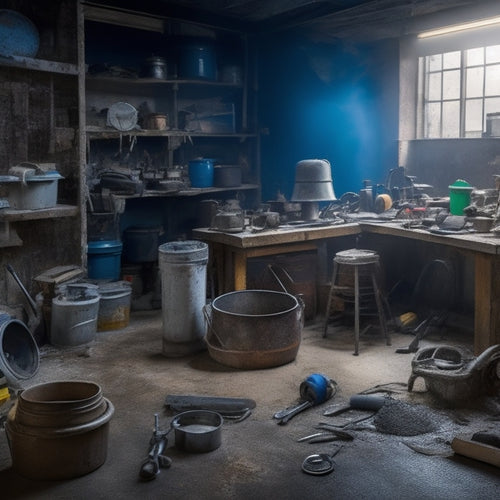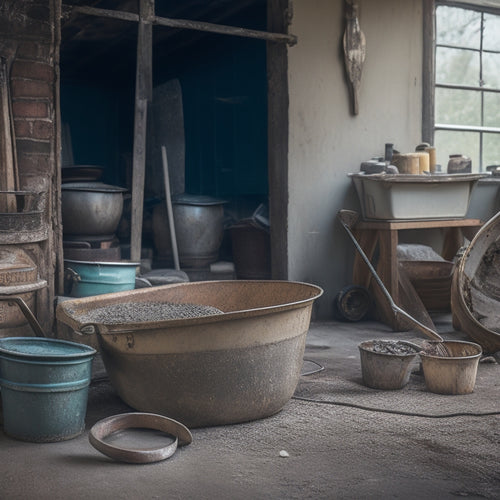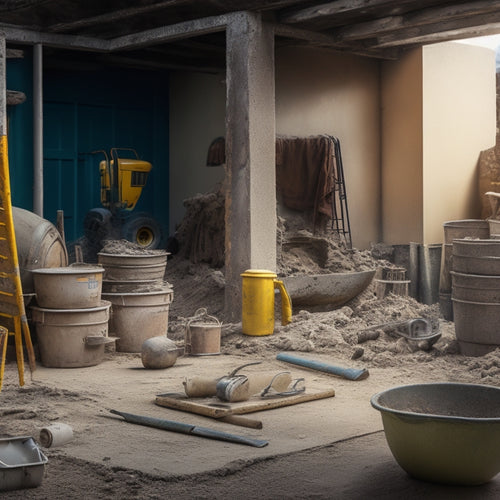
What Tools to Rent for a Concrete Home Reno
Share
When tackling a concrete home renovation, you'll need to rent a variety of specialized tools to get the job done. For demolition, prioritize a pry bar, sledgehammer, and debris disposal equipment. Next, focus on concrete cutting and drilling with saws, drill bits, and walk-behind saws for large, straight cuts. You'll also need block laying and leveling tools, including a spirit level and rubber mallet. Don't forget essential mixing and pouring tools like a concrete mixer and pouring bucket. As you progress, you'll require finishing and smoothing tools, safety gear, and protective wear. Now that you've got the basics covered, you're ready to take it to the next level.
Key Takeaways
- Rent a concrete mixer suitable for your project volume requirements to ensure efficient mixing and pouring.
- Consider renting a walk-behind saw or handheld saw for cutting concrete, depending on the size and complexity of your cuts.
- A pry bar, sledgehammer, and debris disposal container are essential tools for demolition and waste management in a concrete home reno.
- For block laying and leveling, rent a laser level and spirit level to ensure accuracy and precision in your work.
- Don't forget to rent safety gear, including hard hats, eye protection, and dust masks, to protect yourself from hazards on the job site.
Essential Tools for Demolition
As you prepare to tackle the demolition phase of your concrete home renovation, having the right tools at your disposal is crucial to ensuring a safe and efficient process. Demolition techniques require precision and control, and the right tools will help you achieve that.
A pry bar, also known as a wrecking bar, is an indispensable tool for breaking up concrete floors, walls, and foundations. A sledgehammer is another must-have for demolition, providing the brute force needed to crack and break concrete.
Debris disposal is also a significant aspect of demolition. A dumpster or debris container will help you keep the site organized and facilitate the removal of waste materials. A wheelbarrow or dolly can be used to transport heavy debris to the dumpster, making the process more efficient.
Additionally, safety gear such as gloves, safety glasses, and a dust mask should be worn at all times to protect yourself from flying debris and airborne particles.
Concrete Cutting and Drilling
Two essential tasks in concrete home renovation are cutting and drilling, which require specialized tools and techniques to execute efficiently and safely.
You'll need the right saw types and drill bits to make precise cuts and holes in concrete. For cutting, you can rent a walk-behind saw, a handheld saw, or a ring saw, depending on the size and complexity of the job.
Walk-behind saws are ideal for large, straight cuts, while handheld saws are better suited for smaller, curved cuts. Ring saws offer more precision and control.
When it comes to drilling, you'll need drill bits specifically designed for concrete, such as carbide-tipped or diamond-coated bits. These bits can handle the hardness of concrete and provide a clean, precise hole.
Be sure to choose the right drill bit for the type of concrete you're working with and the size of the hole you need to create.
With the right tools and techniques, you'll be able to cut and drill through concrete with confidence and precision.
Block Laying and Leveling
You'll need a solid foundation to secure the success of your concrete home renovation project, and that starts with proper block laying and leveling. The type of blocks you choose will greatly impact the foundation stability of your structure.
You'll need to select blocks that suit your project's requirements, considering factors like load-bearing capacity, durability, and weather resistance. Common block types include concrete masonry units, insulated concrete forms, and autoclaved aerated concrete blocks.
Once you've selected your blocks, it's crucial to lay them correctly to guarantee a level and stable foundation. You'll need a spirit level, a string line, and a rubber mallet to tap the blocks into place. A laser level can also be useful for larger projects, providing accurate and precise leveling.
Remember to check the block courses regularly to verify they're level, plumb, and aligned with the project's specifications. By doing so, you'll create a solid foundation that will support the rest of your renovation project.
Mixing and Pouring Concrete
With the foundation blocks securely in place, attention now turns to mixing and pouring concrete, a critical phase of your renovation project.
You'll need to rent a concrete mixer, which comes in various sizes depending on the scale of your project. Choose a mixer that can handle the volume of concrete you need to pour in one batch.
Mastering concrete mixing techniques is vital to achieving a strong and durable structure. Start by adding the recommended amount of water to the mixer, then gradually add the dry concrete mix while the mixer is running. Use a shovel to scrape the sides and verify all ingredients are well incorporated.
Avoid overmixing, as this can lead to a weak and porous finish.
When pouring concrete, use a chute or a pouring bucket to direct the flow and minimize spills. Work in sections, pouring concrete in a continuous flow to prevent cold joints.
Use a screed board or a tamping tool to level and compact the concrete as you pour. By employing the right pouring methods, you'll achieve a smooth, even surface that sets the stage for the next phase of your renovation project.
Finishing and Smoothing Tools
You'll need a range of finishing and smoothing tools to achieve a professional-looking finish for your concrete renovation project.
To get started, you'll require trowels and edgers to shape and smooth the concrete, ensuring a uniform surface.
Additionally, polishing and grinding tools will help you refine the finish, removing imperfections and revealing the desired level of shine.
Trowels and Edgers
As the concrete begins to set, it's essential to have the right tools on hand to achieve a smooth, even finish. You'll need trowels and edgers to remove excess material, fill gaps, and create a uniform surface.
There are several trowel types to choose from, each suited for specific tasks:
| Trowel Type | Description | Best For |
|---|---|---|
| V-Trowel | Angled blade for removing excess concrete | Large, open areas |
| Notched Trowel | Notches on blade help hold and spread material | Applying thin layers |
| Finishing Trowel | Smooth blade for final finishes | Smoothing and polishing |
| Edger | Used to create clean edges and corners | Borders, corners, and curves |
The benefits of using an edger are clear: clean, defined edges and a professional-looking finish. With the right trowel and edger, you'll be able to achieve a high-quality finish that meets your standards.
Polishing and Grinding
After achieving a uniform surface with trowels and edgers, it's time to focus on the finer details.
Now, you'll shift your attention to polishing and grinding, which demands precision and the right tools. This stage is essential in refining your concrete's texture and appearance.
To achieve a high-gloss finish, you'll need to rent the following polishing and grinding tools:
- Grinding wheels: Coarse-grit wheels for removing imperfections and fine-grit wheels for refining the surface.
- Polishing pads: Diamond-impregnated pads for honing and polishing the concrete.
- Concrete polishers: Walk-behind or handheld machines for efficient polishing and grinding.
- Edge grinders: Specialized tools for polishing and grinding edges, corners, and tight spaces.
Mastering polishing techniques will help you reveal the full potential of your concrete renovation.
Safety Gear and Protective Wear
When you're working with concrete, safety gear and protective wear are essential to preventing injuries.
You'll need a hard hat that meets industry standards to protect your head from falling debris and impact, as well as eye protection that provides a secure seal to prevent dust and particles from getting in.
Hard Hat Essentials
Safety is your lifeline on a concrete home renovation project, and investing in the right hard hat essentials is crucial to protecting yourself from potential hazards.
You never know when a falling object or debris might come crashing down, and having the right gear can mean the difference between a close call and a serious injury.
When it comes to hard hats, you've got options. Consider the following must-haves:
-
Type 1 hard hats: These are the classic hard hats you're familiar with, designed to protect against falling objects and debris.
-
Hard hat accessories: Don't forget to add extra protection with accessories like chin straps, visors, and ear protection.
-
Full-brim hard hats: These offer extra protection for your face and neck from the sun, wind, and debris.
- Ventilated hard hats: Stay cool and comfortable on the job with ventilated hard hats that allow for airflow.
Eye Protection Musts
You've got your hard hat on, but what about protecting your eyes? Eye protection is essential when working with concrete, as the smallest particle can cause significant damage. The importance of eye protection cannot be overstated, as your eyes are one of your most treasured assets.
When choosing the right eyewear, consider the type of task, the level of protection needed, and personal comfort. Here are some common types of eyewear:
| Type | Description | Use |
|---|---|---|
| Safety Glasses | General-purpose protection, often with anti-fog coating | Drilling, sawing, grinding |
| Goggles | Full-face protection, often with ventilation | Sanding, blasting, chemical handling |
| Face Shields | Full-face protection with a clear shield | Heavy-duty grinding, demolition |
Specialized Equipment for Corners
Corners are notoriously tricky areas to work with during a concrete home renovation, as they require precision and attention to detail to avoid uneven surfaces and compromised structural integrity.
You'll need specialized equipment to achieve a professional-looking finish and guarantee the structure remains sound.
To get it right, you'll need the following precision tools:
-
Corner trowels: Designed for corner shaping, these trowels feature a curved blade that allows for smooth, even application of concrete in tight spaces.
-
Radius gauges: These tools help you measure and mark precise curves and angles, ensuring accurate corner construction.
-
Corner floats: Used to smooth and finish concrete in corners, these floats feature a curved or angled edge that reaches into tight spaces.
- Edging tools: These precision tools help you create clean, defined edges and corners, giving your renovation a polished look.
With these specialized tools, you'll be able to tackle corners with confidence, achieving a high-quality finish that enhances the overall look and value of your home.
Frequently Asked Questions
Can I Rent Tools for a Short Period of Time or Only by the Day?
You can rent tools for a short period of time, not just by the day, thanks to flexible short-term rentals and customizable rental agreements that cater to your needs, giving you the freedom to work on your own schedule.
Are Rented Tools Typically Delivered to the Construction Site?
When renting tools, you'll find that delivery options vary, but many suppliers offer on-site delivery or will-call pickup, depending on their rental policies, giving you flexibility to get the tools you need, when and where you need them.
Do Rental Companies Provide Operator Training for Complex Equipment?
As you venture into renting complex equipment, you'll be relieved to know that many rental companies provide operator training to guarantee your safety and equipment maintenance, giving you the confidence to tackle your project with freedom and precision.
How Do I Determine Which Tool Size Is Right for My Project?
You'll determine the right tool size for your project by considering project size considerations, such as area to be covered and material thickness, and following tool selection tips, like choosing equipment that matches your project's specific needs and scale.
Can I Rent Tools on Weekends or Only on Weekdays?
You'll want to check the rental policies of your chosen supplier to see if they offer weekend availability, as some may have limited hours or restrictions, while others might accommodate your weekend renovation schedule with flexible rental options.
Conclusion
Congratulations, you've made it through the concrete home reno tool rental guide! Now you're equipped to tackle that DIY project that'll turn your neighbors green with envy (or concern for their property values). Just remember, with great power comes great responsibility – and a whole lot of dust, noise, and potential chaos. May the odds be ever in your favor, and don't say we didn't warn you about the importance of earplugs.
Related Posts
-

7 Tools to Fix Damaged Concrete Floors
You're about to tackle that damaged concrete floor, and the right tools are essential for a successful repair. Start ...
-

Top Tools for Mixing Concrete at Home
When mixing concrete at home, you'll need a range of tools to guarantee a successful operation. Start with essential ...
-

What Tools Are Needed for Concrete Wall Foundations
You'll need a thorough array of tools and equipment to construct a concrete wall foundation that meets structural int...


